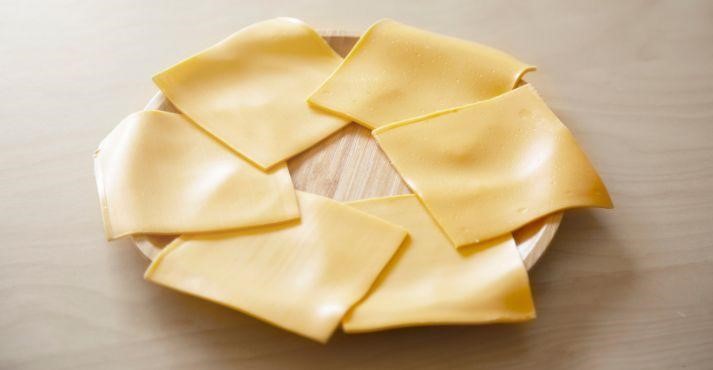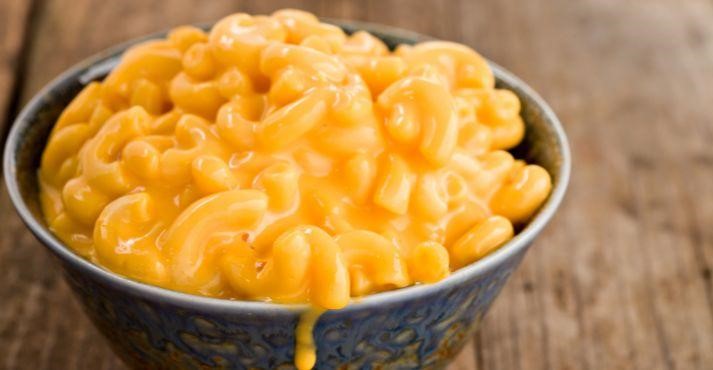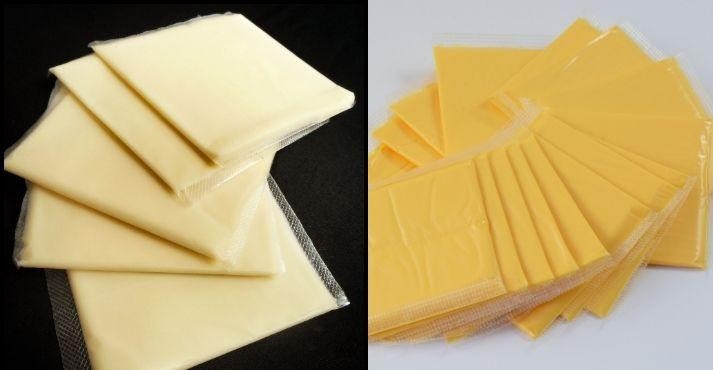Did you know that American Cheese is one of the most popular cheeses in the world? This smooth and creamy cheese is found in many favorite foods, such as cheeseburgers, grilled cheese sandwiches, and macaroni and cheese.
Over 6.4 million metric tons of American Cheese are produced each year! But what is American Cheese exactly, and why is it so important?
Understanding American Cheese is essential for anyone who loves food, especially those working in the food industry. Knowing more about this cheese helps chefs and cooks make tasty dishes and choose the right ingredients.
Let’s explore American cheese: its history, how it’s made, and why so many people love it.
What is American Cheese?

American Cheese is a processed cheese known for its smooth, creamy texture and mild flavor. It is typically made from a blend of American Cheese ingredients, including milk, milk fats, food preservatives, whey, and emulsifying salts.
When heated and mixed, these ingredients create a uniform product that melts quickly, making it perfect for cheeseburgers and grilled cheese sandwiches.
The history of American Cheese dates back to the early 20th century. James L. Kraft, an American entrepreneur, invented American Cheese in 1916.
He developed a process for blending different types of natural cheese with emulsifying salts, which helped create a longer-lasting and more consistent product.
This invention revolutionized the cheese industry and led to the widespread popularity of American Cheese slices and blocks.
American cheese comes in various forms, such as yellow American cheese, which is known for its bright color and is often considered the best choice for melting and cooking due to its unique properties.
Types of American Cheese

American Cheese comes in various forms, each with unique characteristics and uses. Understanding these types can help you choose the right cheese for your culinary needs.
1. Processed American Cheese
Processed American Cheese is the most widely recognized form of American Cheese. It is made by blending one or more types of natural cheese with additional ingredients like milk, emulsifying salts, and food coloring.
This mixture is then heated until it becomes smooth and uniform. Processed American Cheese is known for its excellent melting properties, making it ideal for cheeseburgers, grilled cheese sandwiches, and other hot dishes.
It comes in various flavors, including yellow and white American Cheese, to cater to different tastes and preferences.
2. Natural American Cheese
Natural American Cheese differs from processed varieties in that it is made using traditional cheese-making methods. These methods involve curdling milk with rennet, separating the curds and whey, and then aging the cheese to develop its flavor.
Unlike processed cheese, natural American Cheese does not contain emulsifying salts or other additives, resulting in a more authentic cheese flavor. Examples of natural American Cheese include varieties such as Cheddar and Colby.
3. Variations of American Cheese
Several popular variations of American Cheese include:
- Colby: Known for its mild flavor and semi-soft texture, Colby is similar to Cheddar but with a higher moisture content.
- Monterey Jack: A semi-hard cheese with a mild, buttery flavor, often used in Mexican cuisine.
- Brick Cheese: Named for its brick-like shape, this cheese has a sweet, mild taste when young and becomes intense with age.
- Cheddar is a sharp, flavorful cheese that ranges from mild to extra sharp. It is widely used in cooking and snacking.
- Cream Cheese: A soft, spreadable cheese with a rich and creamy texture, commonly used in baking and as a spread.
- String Cheese: A snack-sized cheese made from mozzarella, known for its peelable, string-like texture.
These variations offer a wide range of flavors and textures, making American Cheese a versatile ingredient in many dishes.
The Culinary Uses of American Cheese

American Cheese is a beloved ingredient in many kitchens, thanks to its smooth texture and excellent melting properties. It plays a crucial role in both classic and modern dishes.
In Classic Dishes
- Burgers: American Cheese is the go-to cheese for burgers, adding a creamy, melt-in-your-mouth layer that perfectly complements the savory beef patty. Whether a simple cheeseburger or a gourmet burger with multiple toppings, American Cheese ensures a consistent, delicious taste that enhances the overall flavor.
- Grilled Cheese Sandwiches: This classic comfort food relies on American Cheese slices to create a gooey, satisfying bite. The cheese melts evenly, providing a perfect blend of crunch from the toasted bread and creaminess from the melted cheese, making it a favorite for kids and adults.
- Macaroni and Cheese: Perhaps one of the most iconic dishes featuring American Cheese, its creamy texture helps create a rich, velvety sauce that coats every piece of pasta. The mild flavor of American Cheese balances well with other ingredients, making this dish a comforting staple in many households.
In Modern Cooking
- Cheese-Stuffed Quesadillas: In fusion dishes like cheese-stuffed quesadillas, American Cheese adds a smooth, melty texture that blends well with other ingredients such as meats, vegetables, and spices. This modern twist on a classic Mexican dish shows the versatility of American Cheese in various culinary traditions.
- Gourmet Pizzas: Grated American Cheese blocks provide a creamy base that pairs well with various toppings, from traditional pepperoni to innovative combinations like arugula and prosciutto. Similarly, you can also pair this cheese with wines. The cheese’s excellent melting properties and mild flavor enhance the overall taste without overpowering other ingredients.
- Cheese Dips and Sauces: American cheese can create smooth and creamy cheese dips, perfect for parties and gatherings. Its consistent melting quality ensures a creamy dip that doesn’t separate, making it ideal for nachos, pretzels, and vegetable platters.
- Casseroles and Bakes: Adding American Cheese to casseroles and baked dishes gives them a creamy, cohesive texture. It can be layered in lasagnas or mixed into potato bakes to add a cheesy goodness that ties the dish together.
Nutritional Information and Health Considerations
American Cheese is a popular choice for many, but it’s essential to understand its nutritional profile and health implications.
Nutritional Profile
American Cheese provides several essential nutrients. A typical slice (about 20 grams) of American Cheese contains approximately:
- Calories: 60-80
- Fat: 4-6 grams
- Saturated Fat: 2-3 grams
- Protein: 3-5 grams
- Sodium: 200-300 milligrams
- Calcium: 10-15% of the daily recommended value
American Cheese is a good source of protein and calcium, which are essential for maintaining muscle and bone health. However, it also contains high levels of saturated fat and sodium, which can be concerning if consumed in large quantities.
Health Implications
Consuming American Cheese can have both positive and adverse health effects. On the positive side, protein supports muscle repair and growth, and calcium helps maintain strong bones and teeth.
These nutrients are crucial, especially for growing children and individuals with high physical activity levels.
However, the high saturated fat content in American cheese slices and blocks can contribute to increased cholesterol levels, which may raise the risk of heart disease if consumed excessively. The high sodium content can also lead to elevated blood pressure and cardiovascular issues.
Moderation is key when incorporating American Cheese into a balanced diet. While it can be enjoyed as part of a healthy eating plan, it’s crucial to balance it with other nutrient-dense foods to ensure a well-rounded diet.
White vs. Yellow American Cheese

1. Color Variation
The primary difference between white American Cheese and yellow American Cheese is the coloring agents used during production.
Yellow American Cheese gets its color from additives like annatto, a natural dye derived from the seeds of the achiote tree. On the other hand, White American Cheese does not contain these coloring agents, retaining the natural color of the cheese blend used in its making.
2. Flavor and Texture
There is little difference between white and yellow American cheese regarding flavor and texture.
Both types share the same creamy texture and mild taste, as the base ingredients and production process are generally the same. Any minor flavor variations are usually due to differences in the cheese blends rather than the color additives.
3. Culinary Uses
Regarding culinary uses, the choice between white and yellow American Cheese often depends on visual preference and the specific dish. Yellow American Cheese is commonly used in classic comfort foods like cheeseburgers and macaroni and cheese, whose vibrant color adds to the visual appeal.
White American Cheese is often preferred in dishes where a more neutral color is desired, such as sure casseroles, white sauces, and gourmet sandwiches.
American Cheese vs. Cheddar Cheese
Taste and Texture
American Cheese has a mild, creamy flavor and a smooth, easily meltable texture. It is known for its consistency and is often used for its melting properties.
In contrast, Cheddar has a sharper, more pronounced flavor that intensifies with age. Depending on its aging process, cheddar’s texture can range from smooth and firm to crumbly.
Ingredients and Processing
The ingredients and production methods for American Cheese and Cheddar differ significantly. American Cheese is made of a blend of natural cheese, milk, emulsifying salts, and other additives, creating a uniform and long-lasting product through processing.
Conversely, Cheddar is a natural cheese made from curdled milk, which is then aged to develop its distinct flavor. Cheddar’s aging process can range from a few months to several years.
Culinary Uses
American Cheese is widely used in dishes that require smooth melting cheese, such as burgers, grilled cheese sandwiches, and macaroni and cheese. Its mild flavor and melting properties make it ideal for these applications.
Cheddar, with its sharper taste, is often used in dishes where a more robust cheese flavor is desired, such as in cheese sauces and casseroles and as a topping for baked dishes. It is also commonly used in sandwiches and as a snack cheese.
What is American Cheese – FAQs
Is American cheese bad for you?
American Cheese can be part of a balanced diet if eaten in moderation. It is high in saturated fat and sodium, which can be harmful in large quantities, but it also provides protein and calcium.
Is American cheese real cheese?
American Cheese is a processed cheese product made from natural cheese and other ingredients. While it contains real cheese, it also includes emulsifiers and additives.
What is white American cheese?
White American Cheese is similar to yellow American Cheese but without the added coloring agents like annatto. It has the same smooth texture and mild flavor.
How long does American cheese last?
Unopened American Cheese can last for several months in the refrigerator. Once opened, it should be consumed within 2 to 3 weeks for best quality.
Is Velveeta American cheese?
Velveeta is a processed cheese product, similar to American Cheese, but with a slightly different formulation that gives it a distinctive smooth and creamy texture.
Conclusion
Wrapping up our journey through American cheese, we’ve discovered a rich tapestry of flavors, culinary uses, cultural significance, and nutritional aspects. This diverse cheese has become a staple in our kitchens, offering various options for various dishes.
American cheese’s culinary presence is nothing short of remarkable. From grilled cheese sandwiches to gourmet macaroni and cheese, its versatility shines through in comfort foods and haute cuisine.
Its ability to melt seamlessly and complement other ingredients has made it a beloved choice in households and restaurants.
Beyond its culinary uses, American cheese holds cultural significance, symbolizing the evolution of our tastes and preferences. It has woven itself into the fabric of our culinary heritage, adapting to changing times while retaining its timeless appeal.
From a nutritional perspective, American cheese provides a good source of calcium and protein, making it a wholesome addition to balanced diets. While moderation is vital, its nutritional benefits contribute to its continued popularity.












